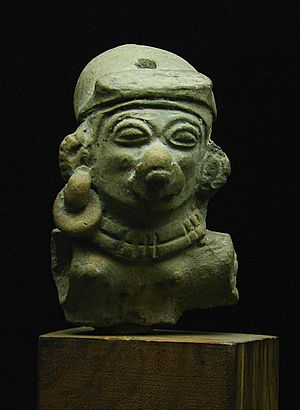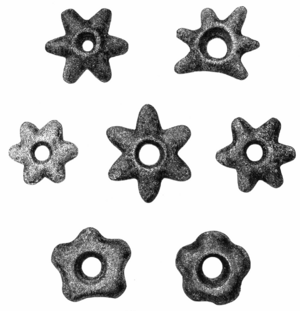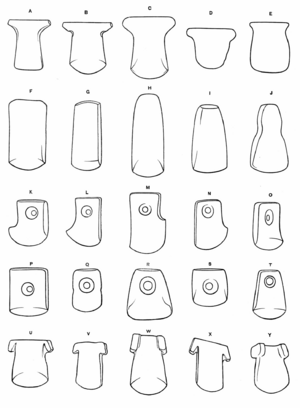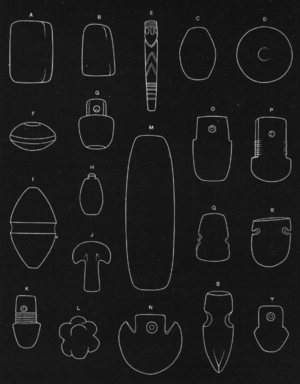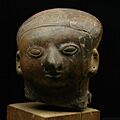Pre-Columbian Ecuador facts for kids
Long, long ago, before Christopher Columbus arrived, many amazing native cultures lived in Ecuador. They thrived for thousands of years before the powerful Inca Empire came along. One of the oldest cultures in the Americas, the Las Vegas culture, lived on Ecuador's coast.
Another important early culture was the Valdivia culture, found along the Pacific coast. Scientists have found ancient Valdivian items from as far back as 3500 BC. These discoveries were made near the modern city of Santa Elena in the Guayas Province.
Other groups like the Quitus, Caras, and Cañaris also grew in different parts of Ecuador. Many ancient sites have been found in coastal areas like Manabí and Esmeraldas. More sites are in the Andean highlands, such as Tungurahua and Chimborazo. These discoveries show that people lived in Ecuador for at least 4,500 years before the Inca arrived.
Large parts of Ecuador, especially the Amazon rainforest (called the Oriente), are still unexplored by archaeologists. This suggests that even more ancient human settlements might be hidden there. Researchers have recently studied the Amazon region. It is so remote and dense that it takes years to explore even small areas. Their belief that complex cultures lived in the river basin was confirmed by finding the Mayo-Chinchipe Cultural Complex in the Zamora-Chinchipe Province.
The country we know today as Ecuador was a central place where many civilizations grew over thousands of years. Before the Inca, people lived in groups called clans. These clans formed large tribes, and some tribes joined together to create strong groups, like the Confederation of Quito. However, none of these groups could stop the mighty Tawantinsuyu. The Inca invasion in the 15th century was very difficult and violent. But once the Inca, led by Huayna Capac, took over the Quito area, they set up a large government and began to settle the region.
The time before Columbus arrived in Ecuador can be split into four main periods:
- Preceramic Period
- Formative Period
- Period of Regional Development
- Period of Integration and the Arrival of the Incas
Contents
Early Stone Age: Preceramic Period
The Preceramic Period began when the first humans settled in Ecuador. This was at the end of the last Ice Age, and it lasted until about 4200 BC. The main cultures during this time were the Las Vegas and Inga cultures.
Las Vegas Culture: First Farmers
The Las Vegas is the first known culture in Ecuador. They lived on the Santa Elena Peninsula on Ecuador's coast. They were there between 9000 and 6000 BC. Skeletons and other finds show that this culture once thrived in the area.
Scientists have found three stages of their cultural growth. The earliest people were hunters, gatherers, and fishermen. Around 6000 BCE, they were among the first to start farming. They grew bottle gourds (a type of squash) and an early kind of maize (corn). The most famous discovery from this culture is The Lovers of Sumpa. These human remains and other items can be seen at the Museo Los Amantes de Sumpa y Centro Cultural in Santa Elena.
El Inga: Nomadic Hunters
The Inga people lived in the mountains near today's Quito. Evidence from the El Inca archaeological site shows this culture existed from 9000–8000 BC. Several sites were dug up around 1961. This area is thought to be one of the most important in South America. It was located along an ancient trade route. The tools used by these early nomadic hunters are similar to those found in the Clovis culture in North America and at Fell's Cave in southern Chile.
Developing Societies: Formative Period
During the Formative Period, people in Ecuador changed from hunting and simple farming. They began to live in more developed societies. This included building permanent homes, increasing their farming, and using pottery.
New cultures appeared during this time. On the coast, there were the Machalilla culture, Valdivia, and Chorrera culture. In the mountains, there were Cotocollao and The Chimba. In the Amazon region (Oriente), cultures like Mayo Chinchipe (4500 BC — AD 1532), Pastaza, and Chiguaza developed. The Cerro Narrío or Chaullabamba culture thrived from 2000 BC to AD 600 in the southern Cañar and Azuay provinces.
Santa Ana (La Florida) is an important archaeological site in the highlands of Ecuador. It dates back as early as 3,500 BC. It is in the Zamora-Chinchipe Province and was found in the 21st century. It is part of what is called the Mayo Chinchipe-Marañón culture.
Valdivia Culture: First Potters
The Valdivia culture is the first culture where many important remains have been found. Their civilization dates back to 3500 BC. The Valdivias were the first people in the Americas to use pottery. They made bowls, jars, and female statues out of clay. These were used for daily life and for religious ceremonies.
They traveled the seas on rafts with sails. They also set up a trade network with tribes in the Andes mountains and the Amazon jungle. Valdivia art and items have been found all over the country. You can see a large collection at the Museo Fianco Banco Central in Quito and the UEES in Guayaquil.
Machalilla Culture: Striped Pottery
After the Valdivia, the Machalilla Culture grew along the coast of Ecuador. This farming culture thrived between 2000 and 1000 BC. Their pottery is easy to tell apart from Valdivia pottery. It was painted black or white with red stripes. Figurines were rare and not as well made. These people seem to be the first to grow corn in this part of South America.
Chorrera Culture: Animal Art
The Chorrera culture existed in the late Formative period. They lived in the Andes and Coastal Regions of Ecuador between 900 and 300 BC. They were best known for their hollow ceramic figures. These figures were shaped like animals and plants.
Growing Differences: Period of Regional Development
The Period of Regional Development was a time when different regions of Ecuador developed their own ways of organizing society and politics. Some of the main cultures during this period were: Jambelí, Guangala, Bahía, Tejar-Daule, La Tolita, and Jama Coaque on the coast. In the mountains, there were Cerro Narrío and Alausí. In the Ecuadorian Amazon jungle, the Tayos culture existed.
La Bahía Culture: Coastal Connections
The Bahía culture (300 BC– AD 500) was important during this time. La Chimba, north of Quito, is the site of the earliest pottery in the northern Andes. It shows the final stage of the Formative Period. The people of Bahía connected with many villages on the coast and in the mountains. They were close to the Cotocollao culture, which was on the Quito plateau. The Bahía culture covered the area from the Andes mountains to the Pacific Ocean. It stretched from Bahía de Caráquez south into Manabí.
The Jama-Coaque culture lived between Cabo San Francisco in Esmeraldas and Bahía de Caráquez in Manabí. This area had wooded hills and wide beaches. This made it easy for them to gather resources from both the jungle and the ocean.
La Tolita Culture: Gold and Art
The La Tolita culture developed in the coastal region of Southern Colombia and Northern Ecuador. This was between 600 BC and AD 200. Many archaeological sites show how artistic this culture was. Their items include gold jewelry, beautiful masks of human-like figures, and statues. These items show a society with different social levels and complex ceremonies.
Guangala Culture: Coastal Life

The Guangala culture thrived from AD 100 to 800. They lived in the Manabí Province.
Uniting Tribes: Period of Integration and the Inca Arrival
During this period, tribes across Ecuador started to come together. They built better homes, which improved their living conditions and made them less affected by the weather. In the mountains, the Cosangua-Píllaro, Capulí, and Piartal-Tuza cultures appeared. In the eastern region, there was the Yasuní Phase. On the coast, the Milagro, Manteña, and Huancavilca cultures developed from 500 BC onwards.
Los Manteños: Master Traders
The Manteños were the last pre-Columbian cultures on the coast. They flourished between 600 and 1534. They were the first to see Spanish ships sailing in the Pacific Ocean. Based on old records and archaeological finds, their civilization stretched from Bahía de Caráquez to Cerro de Hojas in the south.
They were excellent weavers and made textiles. They also created items from gold, silver, spondylus shells, and mother-of-pearl. The Manteños were masters of the sea. They created large trade routes that reached as far south as present-day Chile and as far north as western Mexico. The main center of their culture was in the area of Manta, which was named after them.
Los Huancavilcas: Fierce Warriors
The Huancavilcas were the most important pre-Columbian culture of Guayas, after Las Vegas. These warriors were known for their appearance. The Huancavilca culture has a legend about Guayas and Quiles. The city of Guayaquil was named after them.
Quitu-Cara Culture and the Kingdom of Quito
The Kingdom of Quito was formed by the Quitus, the Puruhaes, and Cañaris. These groups lived in the Andean regions of present-day Ecuador. Their main settlement was where the city of Quito was later built. Its people were called Quitus. The Quitus were somewhat peaceful. Although they formed a small kingdom, they were taken over by the Shyris (Cara culture). These ancient native people then ruled the Kingdom of Quito. The Shyris ruled for more than 700 years before the Inca, led by Tupac Yupanqui, invaded them. The Cañari culture thrived from AD 400 to 1532. The Cañari people still live in Ecuador today.
Some historians, like Jacinto Jijón y Caamaño and Alfredo Pareja Diezcanseco, have questioned if such a Kingdom of Quito truly existed. They point out that there is no clear evidence like ruins or pottery. The existence of the Quitus people does not fully prove the Kingdom of Quito, but it does support the idea that it might have existed.
The Incas: A Powerful Empire Arrives
The Inca civilization expanded northward from modern-day Peru in the late 15th century. They faced strong resistance from several Ecuadorian tribes. This was especially true for the Cañari, who lived near modern-day Cuenca. The Cara people, originally from Manabí, fought alongside the Quitu in the mountains north of Quito. The Quitu were the original inhabitants of the modern capital's site.
The conquest of Ecuador began in 1463. It was led by the ninth Inca ruler, the great warrior Pachacuti Inca Yupanqui. In that year, his son Tupac took command of the army. He began marching northward through the mountains.
By 1500, Tupac's son, Huayna Capac, had overcome the resistance of these groups and the Cara. He then brought most of modern-day Ecuador into Tawantinsuyu, as the Inca empire was known. Some tribes also sought safety in the thick jungles. The Inca rulers, based in Cuzco (modern-day Peru), only had influence for about 50 years in Ecuador. In some parts, it was even less.
During this time, some parts of life stayed the same. For example, traditional religious beliefs continued throughout Inca rule. However, in other areas, like farming, land ownership, and social structure, Inca rule had a big impact, even though it was short.
Emperor Huayna Capac grew very fond of Quito. He made it a second capital of Tawantinsuyu. He lived there in his later years before he died around 1527. Huayna Capac's sudden death from a strange disease, possibly smallpox, led to a fierce power struggle. This was between Huascar, who was the rightful heir, and Atahualpa, a son born to a Quitu princess, who was said to be his father's favorite.
This struggle lasted for about five years before Francisco Pizarro's Spanish expedition arrived in 1532. The most important battle of this civil war was fought in Ecuador, near Riobamba. Huascar's troops, moving north, were defeated by Atahualpa's troops, moving south. Atahualpa's final victory over Huascar happened just days before the Spanish conquerors arrived. This victory was largely due to the loyalty of two of Huayna Capac's best generals, who were based in Quito with Atahualpa. This victory is still a source of national pride for Ecuadorians. It is seen as a rare time when "Ecuador" strongly defeated a "neighboring country."
Life Under Inca Rule in Ecuador
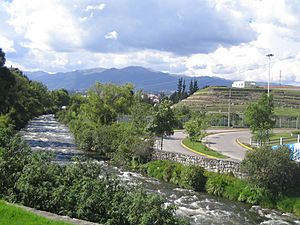
We know more about Ecuador's history from the time of the Inca expansion than from earlier periods. In 1463, the Inca warrior Pachacuti and his son Tupac Yupanqui began to bring Ecuador under Inca rule. They started by defeating the people of the mountains, including the Quitus tribe. The modern city of Quito is named after these people. The Inca then moved southwest to the coast. They eventually brought the Ecuadorians living near the Gulf of Guayaquil and the Island of Puna under Inca control.
By the end of the 15th century, despite strong resistance from several native Ecuadorian tribes, Huayna Capac was able to conquer the remaining tribes. Huayna Capac was Tupac Yupanqui's son with a Cañari princess. By 1500, most of Ecuador was loosely part of the Inca Empire.
Huayna Capac grew up in Ecuador and loved the land. He preferred it over his native Cuzco. He made Quito the second Inca capital, and a road was built to connect the two capitals. Cities and temples were built all over the country. He married a Quitu princess and stayed in Ecuador until he died.
When Huayna Capac died, he left the northern part of the empire to Atahualpa, to be ruled from Quito. The southern part was given to Huascar, to be ruled from Cuzco. Since neither brother liked the idea of a divided empire, they both wanted the throne. Huáscar, born in Cusco, was the rightful heir. Atahualpa, born in Quito according to Ecuadorian history, was seen as the one who tried to take the throne.
The brothers fought for six years. Many people died, and the empire became weaker. Finally, in 1532, near Chimborazo, Atahualpa defeated his brother with help from two of his father's generals. Huáscar was captured and put in prison. Atahualpa became emperor of a very weakened empire. He then had to face the arrival of the Spanish conquerors in 1532.
During the Inca presence, Ecuadorian groups adopted some Inca farming methods and social structures. However, they kept their traditional religious beliefs and many customs. Inca rule in Ecuador was short, lasting about 70 years. But they left one of Ecuador's most famous archaeological sites: Ingapirca. They tried to conquer the high Amazonian valleys but only partly succeeded. In the south, the Bracamoros defeated them three times.
Ancient Objects and Tools
Edward Whymper looked for Stone Age objects in Ecuador in 1880. Most of the items he collected were made of stone. He thought that most metal items had been melted down for their gold.
Macanas: Stone Stars
The most common object found was a stone star with a hole in the middle. They were found everywhere between Ibarra and Riobamba. Most of them have six points that are evenly spaced. They are shaped the same on both sides. Some have only five points, and a few are uneven. All have a hole drilled from both sides. The size of this hole varies a lot.
These stars range from three to five inches wide and three-quarters of an inch to two inches thick. They weigh from five to twenty ounces. Most are made from basaltic rock and gabbro. Similar objects were also made from metal, but these are rare in Ecuador now. While they are similar, almost no two are exactly alike. Some are flat and thin, others are thick, or rise in the center like a wheel hub.
Reports from a U.S. Naval expedition show two bronze stars found in Cuzco, Peru. One has a sixth point extended into a hatchet shape. This suggests it might have been a war-club or battle-axe. In Squire's book on Peru, there is a picture of a six-pointed bronze object. It was called a casse-têtes (head-breaker). He said that many broken skulls found seemed to have been hit by such weapons.
Monsieur Wiener, in his book on Peru and Bolivia, shows a star found at Ancon (archaeological site) near Lima with a stick in its central hole. He also shows a similar bronze one with a handle. Like Squier, he calls them casse-têtes. Doctors Reiss and Stübel noted that the six-pointed stone star was rare at Ancon but common in other Peruvian graves.
Although these writers thought these objects were battle-axes, some points suggest they were not always used as weapons. The larger stars, weighing over a pound, could be effective. But smaller ones, weighing only a few ounces, would not be very strong. Many are undamaged and seem unused. Francisco Campaña, who helped Whymper, said these stone stars were found on the chests of bodies in Peruvian graves. It seems likely they were symbols of the sun, which the Inca worshipped. These weapons are known as Macanas. They were used by armies in many Andean and Mesoamerican cultures for centuries until the Spanish conquest. They were very effective.
Tools and Implements
Many stone objects found were clearly tools. Five types are shown in the illustration with a white background. The top row (A-E) shows tools with rounded edges, except at the bottom. The next row (F-J) shows chisel-like tools. Their tops and sides are sometimes flat or angular, sometimes rounded. The cutting edges are sharp.
The tools in the next row (K-O) look a bit like a bill-hook. Their top edges are flat, and all have holes drilled from both sides. The next row (P-T) has similar holes but are more like chisels. The last row (U-Y) is different. These tools have projecting shoulders. Sometimes, they have a groove along the top edge, probably for easier handling.
All five types were found in large numbers in many places. They were clearly common tools during the Stone Age in Ecuador. They vary a lot in size, thickness, and weight. Type P-T was the most common. Most have holes drilled from both sides, making the hole narrower in the middle. The holes are usually near the top. The bottom edge is always the sharpest. While many would not cut well, a few were sharp enough to cut wood. Their weight ranges from 3¼ to 29 ounces. Like the stone stars, they were made from different types of rocks.
Many other stone tools were found, some shown in the illustration with a black background. Those marked E, J, K, L, N-T are unique. Others are rare. The central one, marked M, was the only object for which Ecuadorian natives knew its use. They said it was a corn-pounder. This one weighs five and a quarter pounds. Another one found weighed eleven pounds.
Several tools like form I were found. Thomas Ewbank thought they were "hollowing-hammers for metal" used with a flexible wooden handle. Objects A, B, and C might have been used for the same purpose. Objects D, F, G, and H are more puzzling. The latter two are similar but lack the round holes on the sides. These tools are well-made from hard stone. It seems likely they were used for sharpening other tools. Examples G and H might be unused ones. Monsieur Wiener also found them in Peru.
Among the decorative stone objects, there are imitations of corn cobs. These were mentioned in Juan & Ulloa's work in the mid-18th century. Spanish writers said: "The maize has ever been the delight of the Indians; for, besides being their food, their favourite liquor chicha was made of it; the Indian artists therefore used to shew their skill in making ears of it in a kind of very hard stone; and so perfect was the resemblance that they could hardly be distinguished by the eye from nature; especially as the colour was imitated to the greatest perfection; some represented the yellow maize, some the white ... The most surprising circumstance of the whole is, the manner of their working, which, when we consider their want of instruments and the wretched form of those they had, appears an inexplicable mystery: for either they worked with copper tools, a metal little able to resist the hardness of stones, or, to give the nice polish conspicuous on their works, other stones must have been used as tools."
Squier's book on Peru shows a poor picture of one of these stone corn-heads. He says they were mentioned by Padre Arriaga in his book on Extirpation of Idolatry in Peru as zaramama. They were household gods of the ancient people.
Age of the Objects
Most of these stone objects and tools are very old. This is clear because they are barely mentioned during the time of the Pizarros (Spanish conquerors). Garcilaso de la Vega said that the native people: "knew not the invention of putting a handle of Wood to their Hammers, but worked with certain Instruments they had made of Copper, mixed with a sort of fine Brass. Neither did they know how to make Files or Graving-tools, or Bellows for Melting down Metals ... But above all, their Carpenters seemed to be worst provided with Tools; for though ours use many Instruments made of Iron, those of Peru had no other than a Hatchet, and a Pick-axe made of Copper; they neither had Saw, nor Augre, nor Planer, nor any other Tool for the Carpenter's work, so that they could not make Arches or Portals for doors; onely they hewed and cut their Timber, and whitened it, and then it was prepared for their Building: And for making their Hatchets and Pick-axes, and some few Rakes, they made use of the Silversmiths, for as yet they had not attained to the Art of Working in Iron. Nor did they know how to make Nails, or use them, but tied all their timber with Cords of Hemp. Nor were their Hewers of Stone more artificial, for in cutting and shaping their Stones, they had no other Tool, than one made with some sharp Flints and Pebbles, with which they rather wore out the Stone by continual rubbing, than cutting."
From this writing, it seems that during the Pizarro era, native people mostly used metal tools. The last sentence likely refers only to shaping stones for building. Older writers generally did not suggest that there was a Stone Age.
Images for kids
-
Cashaloma cup with dripped ("goteado") painting, Museo de las Culturas Aborigenes, Cuenca, Ecuador
See also
 In Spanish: Historia prehispánica de la costa ecuatoriana para niños
In Spanish: Historia prehispánica de la costa ecuatoriana para niños



